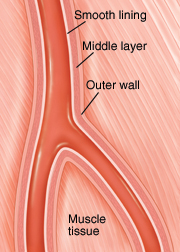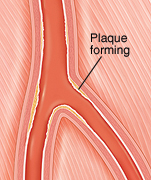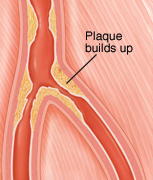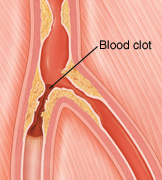Understanding Peripheral Arterial Disease
Peripheral arteries deliver oxygen-rich blood to the tissues outside the heart. As you age, your arteries become stiffer and thicker. Things such as smoking and high cholesterol can also damage the artery lining. This allows a buildup of fat and other materials (plaque) to form within the artery walls. The buildup of plaque narrows the space inside the artery and sometimes blocks blood flow. Peripheral arterial disease (PAD) happens when blood flow through the arteries is reduced because of plaque buildup. It often happens in the legs and feet. But it can also happen elsewhere in the body. It can lead to stroke if this buildup happens in the large artery in the neck (carotid artery).
A healthy artery
An artery is a muscular tube that carries oxygen rich blood and nutrients from the heart to the rest of the body. It has a smooth lining and flexible walls that allow blood to pass freely. When active, muscles need more oxygen. This increases blood flow. Healthy arteries can adapt to meet this need.

A damaged artery
PAD starts when the lining of an artery is damaged. This is often because of risk factors, such as smoking, older age, or diabetes. Plaque then starts to form within the artery wall. At this stage, blood flows normally, so you’re not likely to have symptoms.

A narrowed artery
If plaque continues to build up, the space inside the artery narrows. The artery walls become less able to expand. The artery still provides enough blood and oxygen to your muscles during rest. But when you’re active, the increased demand for blood can’t be met. As a result, your leg may cramp or ache when you walk.

A blocked artery
An artery can become blocked by plaque or by a blood clot lodged in a narrowed section. When this happens, oxygen can’t reach the muscle below the blockage. Then you may feel pain when lying down or when you are not active (rest pain). This type of pain is especially common at night when you’re lying flat. In time, the affected tissue can die. This can lead to the loss of a toe or foot.

Online Medical Reviewer:
Anne Fetterman RN BSN
Online Medical Reviewer:
Deepak Sudheendra MD
Online Medical Reviewer:
Raymond Kent Turley BSN MSN RN
Date Last Reviewed:
2/1/2022
© 2000-2024 The StayWell Company, LLC. All rights reserved. This information is not intended as a substitute for professional medical care. Always follow your healthcare professional's instructions.